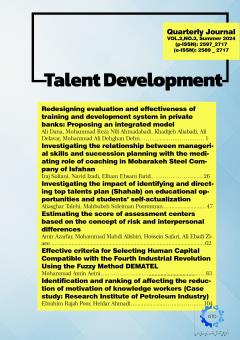Estimating the score of assessment centers based on the concept of risk and interpersonal differences
Subject Areas : Patterns of human capital talent managementامیر آذرفر 1 , MohamadMahdi Alishiri 2 , Hossein Safari 3 , ali ebadi 4
1 - Tehran University
2 -
3 - University of Tehran
4 - University of Tehran
Keywords: Assessment Center, Final Score Estimation, Risk Based Assessment Center Score, Interpersonal Distinctions,
Abstract :
One of the methods are used to assess and evaluate employees is the evaluation center. Evaluation centers usually have good validity at the tool level, but there are weaknesses at the model level of estimating the final score of evaluation centers. This research is designed to provide a method to estimate the final score of assessment centers based on the concept of risk and taking into account interpersonal differences. For this purpose, the data of the evaluation center of 800 managers of the country has been used. In this research, nine different models have been designed and evaluated, and finally, the model with the lowest error rate is presented as the selected model.
1) Bowen, D., & Ostroff, C. (2004). Understanding HRM- Firm Performance Linkage: The Role of the 'Strength' of the HRM System. Academy of Management Review, 203-221.
2) International Task Force on AC Guidelines. (2009). Guidelines and ethical considerations for assessment center operations. International Journal of Selection and Assessment, 243-253.
3) Gaugler, B., & Pohley, K. (1997). A Survey of Assessment Center practices in Organizations in the United States. PERSONNEL PSYCHOLOGY, 71-91.
4) Huck, J. (1973). Assessment centers: A review of the external and internal validities. PERSONNEL PSYCHOLOGY, 191-212.
5) Lievens, F. (2009). Assessment centres: A tale about dimensions, exercises, and dancing bears. European Journal of Work and Organizational Psychology, 102-121.
6) Lane, S., & Stone, C. (2006). Performance assesment. Educational measurement, 387-424.
7) Adamo, G. (2003). Simulated and standardizes patient in OSCEs: Achievements and challenges. Medical Teacher, 262-270.
8) Pecheone, R., & Chung, R. (2006). Evidence in teacher sducation- The Performance Assessment for California Teachers (PACT). Journal of Teacher Education, 22-36.
9) Harvey, P., Velligan, D., & Bellack, A. (2007). Performance- based measures of functional skills: Usefulness in clinical treatment studies. Schizophrenia Bulletin, 1138-1148.
10) Borman, W. (2012). Mimensions, task and mixed models: An analysis of the three diverse perspectives on assessment centers. The psychology of assessment center, 309-320.
11) Tell, R., & Burnett, D. (2003). A perdonality trail-based interactionist model of job performnce. Journal of Applied Psychology, 500-517.
12) Campion, M., & Ployhart, R. (2013). Assessing personality with situational judgment measures: Interactionist psychology operationalizes. New York: Handbook of personality at work.
13) Jansen, A., Melchers, K., Leivens, F., Kleinmann, M., Brandli, M., Fraefel, L., & Konig, C. (2013). Situation assessment as an ignored factor in the behavioral consistency paradigm underlying the validiy of personnel selection peocedures. Journal of Applied Psychology, 326-341.
14) Ulrich, D. (1989). Measuring human resource effectiveness: Stakeholder, index, and relationship approaches. Human Resource Planning, 301-315.
15) Woehr, D., Arthur, W., & Jr. (2003). The construct-related validity of assessment center ratings: A review and meta-analysis of the role of methodological factors. Journal of Management, 231-258.
16) Struch, M., Frank, F., & Amato, A. (1980). Effects of assessor training on subsequent performance as an assessee. Journal of Assessment Center Technology, 17-22.
17) Huck, J., & Bray, D. (1976). Management assessment center evaluations and subsequent job performance of white and black females. PERSONNEL PSYCHOLOGY, 13-30.
18) Schmitt, N., Jennings, D., & Toney, R. (1999). Can We Develop Measures of Hypothetical Constructs? Human Resource Management Review 9, 169-183.
19) Gaugler, B., Rosenthal, D., Thornton, G., & Bentson, C. (1987). Meta-analysis of assessment center validity. Journal of applied psycjology, 493.
20) Gatewood, R., Feild, H., & Barrick, M. (2010). Human Resource Selection. Cengage Learning.
21) George, W. (1971). Development and Use of Weighted Application Blank. University of Minnesota.
22) Lyer, S., & Sharda, R. (2009). Prediction of athletes performance using neural networks: An application in cricket team selection. Expert System with Applications, 5510-5522.
23) Maszczyk, A., Golas, A., Pietraszewski, P., Roczniok, R., Zajac, A., & Stanula, A. (2014). Application of neural and regression models in sports results prediction. Procedia-Soci Behavio Sci.
24) Leung, C., & Joseph, k. (2014). Sports data mining: predicting results for the college football games. Procedia Computer Science, 710-719.
25) Knottenbelt, W., Spanias, D., & Madurska, A. (2012). A common-opponent stochastic model for predicting the outcome of professional tennis matches. Computer & Mathematics with Applications, 3820-3827.
26) Salas, E., Shuffler, M., Thayer, A., Bedwell, W., & Lazzara, E. (2015). Understanding and improving teamwork in organizations: A scientifically based practical guide. Human resource management, 599-622.
27) Sanchez-Anguix, V., Julian, V., Botti, V., & García-Fornes, A. (2013). Tasks for agent-based negotiation teams: Analysis, review, and challenges. Engineering Applications of Artificial Intelligence, 26(10), 2480-2494.
28) Wahesh, E., & Myers, J. (2014). Principles and practices of leadership excellence: CSI chapter presidents' experience, preceived competence, and rankings of importance. Journal of Counselor Leadership and Advocacy, 83-97.
29) Lin, F., Fardad, M., & Jovanović, M. R. (2014). Algorithms for leader selection in stochastically forced consensus networks. IEEE Transactions on Automatic Control, 59(7), 1789-1802.
30) Zhang, L., & Zhang, X. (2013). Multi-objective team formation optimization for new product development. Computers & Industrial Engineering, 64(3), 804-811.
31) Wang, J., & Zhang, J. (2015). A win–win team formation problem based on the negotiation. Engineering Applications of Artificial Intelligence, 44, 137-152.
32) Tavana, M., Azizi, F., Azizi, F., & Behzadian, M. (2013). A fuzzy inference system with application to player selection and team formation in multi-player sports. Sport Management Review, 16(1), 97-110.
33) Meneghel, I., Martínez, I. M., & Salanova, M. (2016). Job-related antecedents of team resilience and improved team performance. Personnel Review.
34) Ding, X., Li, Q., Zhang, H., Sheng, Z., & Wang, Z. (2017). Linking transformational leadership and work outcomes in temporary organizations: A social identity approach. International Journal of Project Management, 35(4), 543-556.


